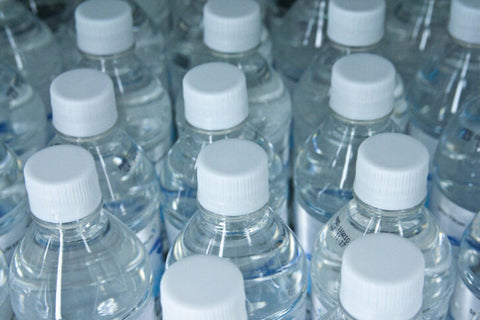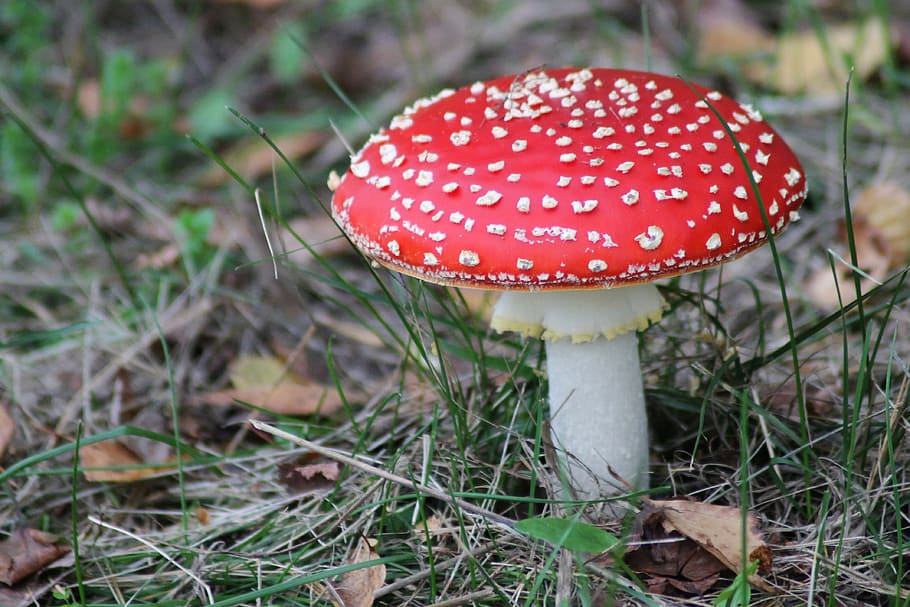Many ingredients used in cosmetic, skincare, and even cleaning products have very little government oversight and therefore, not well regulated. Therefore, as a consumer, it is important to be conscious about what your household and beauty products have inside of them. Knowledge is power! Clean ingredients are definitely a beauty trend we can get behind!
1. Talc

Many women use talcum powder as part of their daily feminine hygiene routine. But epidemiological studies establish a correlation between talc use in the female genital area and ovarian cancer, and call its safety into question. (Photo: Austin Kirk, Flickr CC BY 2.0)
Ingredient Label Listing: Talcum Powder, Cosmetic Talc
What is Talc?
Talc is a mineral made up of magnesium, silicon, oxygen, and hydrogen. As a powder, it helps absorb moisture and prevent friction. The concern surrounding Talc is the common presence of asbestos; a known carcinogen.
What is Talc found in?
Baby powder, body and shower products, lotions, feminine hygiene products, eyeshadow, foundation, lipstick, deodorants, face masks, some food products (like rice and chewing gum) and used in some pharmaceutical tablets.
What are the health threats of Talc?
Respiratory Irritation - several studies have shown that when inhaled, talc can cause severe lung irritation. Cancer - Talc has been linked to lung, ovarian and endometrial cancers. Organ Malfunction - Talc can cause labored breathing and coughing; inflammation and infection in the female genital system
2. MEA, DEA, TEA

Jean Beaufort has released this “Sunscreen” image under Public Domain license. CC0 Public Domain. (Photo: Jean Beaufort, CCO Public Domain)
Ingredient Label Listing: Triethanolamine, diethanolamine, DEA, TEA, cocamide DEA, cocamide MEA, DEA-cetyl phosphate, DEA oleth-3 phosphate, lauramide DEA, linoleamide MEA, myristamide DEA, oleamide DEA, stearamide MEA, TEA-lauryl sulfate.
What are MEA, DEA, TEA?
Ethanolamines are a chemical group that are composed of alcohols and amino acids. Diethanolamine (DEA) and triethanolamine (TEA) are part of this chemical group. DEA is used in shampoos, conditioners and soaps as an emulsifier. TEA is also an emulsifying agent and helps adjust PH. When these ethanolamines are mixed with other preservatives they produce several carcinogenic chemicals.
What is MEA, DEA, or TEA found in?
Hair products, cosmetic products, household cleaning products, sunscreens, lotions, fragrances, dyes, shaving creams, pharmaceutical ointments.
What are the health threats of MEA, DEA, or TEA?
Cancer - specifically of the liver and nasal cavities Toxin Build-Up - Up to 68% of DEA from personal care and cosmetic products can remain on the upper layers of skin for several weeks after initial exposure. Organ Malfunction - DEA can alter sperm structure and cause reproductive/fertility issues; DEA build-up can happen in the liver and kidneys causing malfunctions.
3. MIT/Methylisothiazolinone
Ingredient Label Listing: Methylisothiazolinone
What is MIT?
Methylisothiazolinone is a preservative that is efficient against bacteria.
What is MIT found in?
Beauty and body care products such as bath and shower products, hand sanitizer, makeup, baby products, lotion, masks, and more.
What are the health threats of MIT?
MIT is proven to be a human skin toxicant or allergen and an In-vitro study demonstrates this common biocide is highly toxic to neurons.
4. Toluene

Photo: Purple nail polish on white background by Marco Verch under Creative Commons 2.0
Ingredient Label Listing: Toluene
What is Toluene?
Toluene is naturally found in crude oil and is added to gasoline and used to make many products like paint thinners, adhesives, dyes, rubber, and more. When using it in nail polish, it is the ingredient that allows for a smooth finish.
What is Toluene found in?
Nail polish and hair dyes
What are the health threats of Toluene?
Developmental and reproductive toxicity, organ system toxicity, irritation
5. Triclosan

Photo: Pouring toothpaste on a toothbursh by Marco Verch under Creative Commons 2.0
Ingredient Label Listing: Triclosan (TSC) & Triclocarban (TCC)
What is Triclosan?
Triclosan is a microbial agent that is found in a variety of antibacterial products that is meant to kill bacteria and fungus, and prevent odors.
What is Triclosan found in?
Triclosan is commonly found in soaps, deodorants, detergents, toothpaste, cosmetics, fabrics, and more.
What are the health threats of Triclosan?
There have been studies that prove that Triclosan is an endocrine disruptor that impacts thyroid function and thyroid homeostasis. Triclosan is also an environmental toxin, killing off algae, fish, and crustaceans.
6. Sodium Lauryl Sulfate

This file is from Pixabay, where the creator has released it explicitly under the license Creative Commons Zero (see here)
Ingredient Label Listing: SLS
What is SLS?
Sodium Lauryl Sulfate is a cleansing agent
What is SLS commonly found in?
Surface cleanser, emulsifier
What are the health threats of SLS?
It is known as a “primary irritant” which is a substance that irritates the skin immediately without any prior sensitization.
7. Formaldehyde releasers
Ingredient Label Listing: Formaldehyde, quaternium-15, DMDM hydantoin, imidazolidinyl urea, diazolidinyl urea, polyoxymethylene urea, sodium hydroxymethylglycinate, 2-bromo-2-nitropropane-1,3-diol (bronopol) and glyoxal.
What are Formaldehyde Releasers?
Formaldehyde is a colorless, strong-smelling gas. Formaldehyde-releasing preservatives are chemicals that help prevent microbes from growing in water-based products.
What are Formaldehyde Releasers found in?
Nail polish, nail glue, eyelash glue, hair gel, hair-smoothing products, baby shampoo, body soap, body wash, color cosmetics.
What are the health threats of Formaldehyde Releasers?
These preservatives can be absorbed through the skin and have been linked to cancer and allergic skin reactions.
8. Petrolatum
Ingredient Label Listing: Petrolatum, Petroleum Jelly, Paraffin Oil, Mineral Oil and White Petrolatum
What is Petrolatum?
Petrolatum is a semisolid mixture of hydrocarbons obtained from petroleum.
What is Petrolatum found in?
Cosmetics and lotions
What are the health threats of Petrolatum?
The main health concern regarding Petrolatum is that there is potential contamination with PAHs which can contain carcinogens and therefore, cause cancer.
9. Parabens

Ingredient Label Listing: Ingredients ending in “paraben” (propylparaben, isobutylparaben, isopropylparaben)
What are Parabens?
Parabens are a group of chemicals that are used as artificial preservatives that are found in many cosmetic and body care products. When it comes to finding parabens in cosmetics, the six most-commonly used are The most commonly used six types are methyl-, ethyl-, propyl-, isopropyl-, butyl- and isobutylparaben.
What are Parabens commonly found in?
Beauty products like shampoo, conditioner, toothpaste, lotion, cleansers, sunscreen, deodorant, shaving gels, and other skincare products. Parabens can also be found as a preservative in foods and beverages.
What are the health threats of Parabens?
Parabens can act as the hormone estrogen, disrupting the normal function of the hormone system, affecting both male and female reproductive systems, encompassing development, fertility, and birth outcomes.
10. Phthalates

Bottled Water Macros December 02, 20106 by Flikr user Steven Depolo used under Creative Commons Attribution 2.0 license
Ingredient Label Listing: Phthalate, DEP, DBP, DEHP
What are Phthalates?
Phthalates are a group of industrial chemicals.
What are Phthalates found in?
Used to make plastics more durable, colored cosmetics, fragranced lotions, nail polish, body wash, and hair products
What are the health threats of Phthalates?
Can cause damage to the liver, kidneys, lungs, and reproductive system. Where Phthalates can be harmful to both male and female reproductive systems, female reproductive systems are less sensitive to Phthalates than male reproductive systems.
11. Coal Tar
Ingredient Label Listing: Coal Tar
What is Coal Tar?
It is a byproduct of processing coal. Coal is notoriously known for Black Lung disease in coal miners due to inhaling the coal particles.
What is Coal Tar found in?
Shampoo and hair dyes
What are the health threats of Coal Tar?
As a known human carcinogen, Coal Tar can cause cancer, negative skin reactions like dermatitis and severe rashes, and is also a respiratory toxin.
12. Benzophenone
Ingredient Label Listing: Benzophenone, or ingredients listed as Benzophenone (Benzophenone-2) or BP# (BP2)
What is Benzophenone?
Benzophenone is a masking/UV absorber for household and beauty products.
What is Benzophenone commonly found in?
Cosmetics and skincare products such as nail polish, lip balm, lipstick, baby wipes, sunscreen, hair care, foundation, and moisturizers.
What are the health threats of Benzophenone?
Benzophenone is a human carcinogen and can lead to several types of tumors. It can also affect the endocrine system indirectly by changing gene expression.


